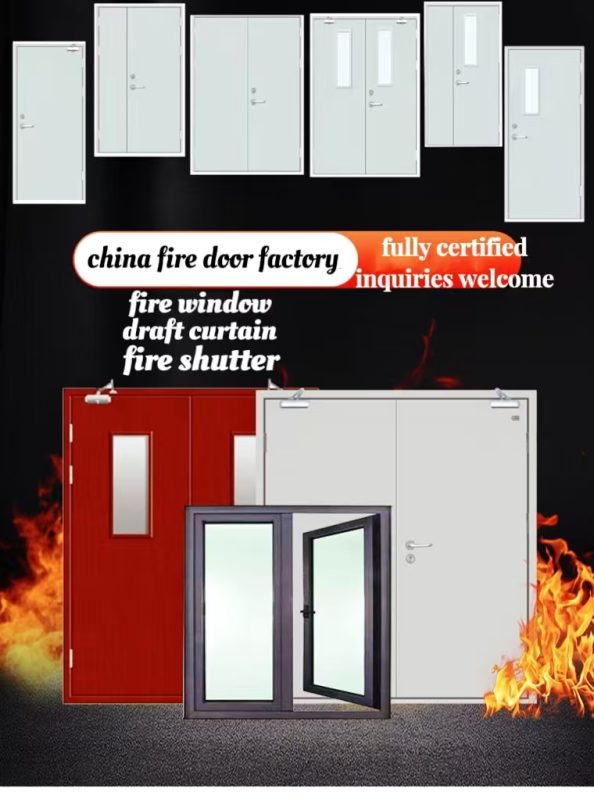Key Differences Between Class A and Class B Fire Doors: A Comprehensive Guide
- 1. Fire Resistance Duration
- 2. Fire Door Materials
- 3. Application Areas
- 4. Thickness of Fire-Resistant Insulation
- 5. Installation Locations
- 6. Price Differences
- Final Thoughts
As a leading fire door manufacturer in China, we understand that choosing the right fire door is crucial for ensuring safety and compliance with national standards. In this article, we will explore the fundamental differences between Class A fire doors and Class B Flame-Retardant doors, including fire resistance ratings, materials, applications, and other key factors. Understanding these differences can help construction professionals and building managers make informed decisions when selecting fire doors.
1. Fire Resistance Duration
One of the primary distinctions between Class A and Class B fire resistance doors lies in their fire resistance duration.
- Class A fire doors are designed to withstand fire for 1.5 hours. This extended duration offers greater protection in high-risk environments where maximum safety is critical.
- In contrast, Class B fire doors provide 1-hour fire resistance, making them suitable for areas that require moderate fire protection.
The fire resistance time is a crucial indicator of a fire door’s classification, as it directly affects the door’s ability to contain flames and smoke during a fire emergency.
2. Fire Door Materials

The materials used in the construction of Class A and Class B Flame-Retardant doors also vary significantly.
- Class A fire doors are primarily made from steel and wood, offering superior durability and fire resistance.
- Class B fire resistance doors can be constructed from wood, steel, or a combination of steel and wood, and even stone materials, depending on the specific application.
The choice of material impacts both the door’s fire resistance rating and its suitability for different environments.
3. Application Areas
Due to their higher fire resistance rating, Class A fire doors are typically installed in high-risk areas, such as:
- Fire pump rooms
- Electrical control rooms
- Generator rooms
- Oil depots
- Warehouses
These locations often contain sensitive equipment or hazardous materials, requiring enhanced protection.
On the other hand, Class B fire rated doors are commonly used in standard fire evacuation routes, including:
- Enclosed stairwells
- Smoke-proof staircases
- Fire elevator lobbies
These areas have lower fire risk but still require reliable containment to ensure the safety of occupants during a fire.
4. Thickness of Fire-Resistant Insulation
While the steel thickness of both Class A and Class B fire rated doors is typically the same—1.2mm for the frame and 0.8mm for the door leaf—the difference lies in the thickness of the fire-resistant insulation inside the door:
- Class A fire doors have an insulation thickness of 52mm with a total door leaf thickness of 54mm, providing superior fire resistance.
- Class B fire resistance doors feature an insulation thickness of 46mm and a door leaf thickness of 48mm.
This extra thickness in Class A fire doors offers increased protection against the spread of fire and heat.
5. Installation Locations
The choice between Class A and Class B High-Temperature Resistant doors depends on the specific requirements of the building.
- Class A fire doors are generally used in critical areas such as hospitals, shopping malls, warehouses, and equipment rooms. These spaces demand a higher level of fire protection due to their increased risk of fire incidents.
- In contrast, Class B High-Temperature Resistant doors are more commonly found in residential buildings, office spaces, and schools. These locations have lower fire risks but still require compliance with fire safety regulations.
6. Price Differences
Due to the higher level of protection offered, Class A High-Temperature Resistant doors are typically more expensive than Class B High-Temperature Resistant doors. The superior materials, thicker insulation, and extended fire resistance rating contribute to the higher cost. However, the investment in Class A fire doors is often justified for areas where maximum fire protection is necessary.
Conversely, Class B Flame-Retardant doors are more cost-effective and are suitable for buildings with lower fire risks.
Final Thoughts

Selecting the right fire door for your building depends on understanding the specific fire protection needs and ensuring compliance with safety regulations. Both Class A High-Temperature Resistant doors and Class B Flame-Retardant doors must undergo rigorous testing and meet market standards before being sold. To ensure the highest level of safety, always request fire test reports from your fire door manufacturer to verify the product’s specifications, materials, and dimensions.
By choosing a reliable fire door manufacturer, you can ensure that your building is equipped with high-quality fire doors that meet both safety standards and performance expectations.
Application scenarios of Class A, B, and C High-Temperature Resistant doors

Safety First: Fire doors are essential for enhancing safety in buildings. They help to contain fires and prevent smoke from spreading, giving occupants more time to evacuate.